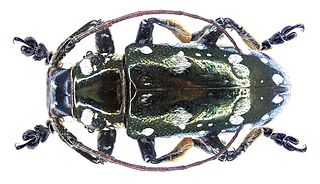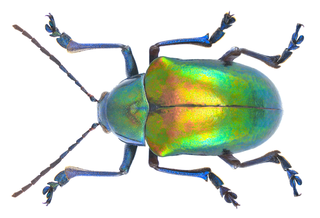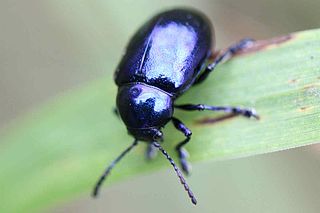
Bromius obscurus, the western grape rootworm, is a species of beetle in the leaf beetle family. It is the only member of the genus Bromius. The distribution of the species is holarctic; it can be found in North America, wide parts of Europe, and Asia. The species is a known pest of grape vines in Europe and western North America.
Acanthocinini is a tribe of longhorn beetles of the subfamily Lamiinae. It was described by Blanchard in 1845.

Clytini is a tribe of beetles in the subfamily Cerambycinae, containing the following genera:
Cycnoderus is a genus of beetles in the family Cerambycidae, containing the following species:

Ceroplesis is a genus of flat-faced longhorn beetle in the subfamily Lamiinae of the family Cerambycidae.

Chlorophorus is a genus of round-necked longhorn beetles belonging to the family Cerambycidae, subfamily Cerambycinae.
Tanymecini is a tribe of broad-nosed weevils in the beetle family Curculionidae, subfamily Entiminae.

Desmiphorini is a tribe of longhorn beetles of the subfamily Lamiinae.

Pteropliini is a tribe of longhorn beetles of the subfamily Lamiinae.

Saperdini is a tribe of longhorn beetles of the subfamily Lamiinae.

Crossotini is a tribe of longhorn beetles of the subfamily Lamiinae. It was described by Thomson in 1864.
Apodasya is a genus of flat-faced longhorns in the beetle family Cerambycidae. There are at least two described species in Apodasya, found in Africa.

Planodes is a genus of longhorn beetles of the subfamily Lamiinae, containing the following species:

Eumolpus is a genus of leaf beetles in the subfamily Eumolpinae. It includes 40 species, most of which have a large size and include some of the largest members of the subfamily. They are distributed throughout the Neotropical realm, though one species has been recorded as far north as Arizona.

Chaetosoma is a genus of beetles in the family Chaetosomatidae. There are at least two described species in Chaetosoma, found in New Zealand.
Neoerethistes is a genus of true weevils in the beetle family Curculionidae. There are more than 30 described species in Neoerethistes. The only species in North American north of Mexico is Neoerethistes arizonicus, found in the southwestern United States.

Chrysochus is a genus of leaf beetles in the subfamily Eumolpinae. It is known from North America, Europe and Asia.

Demonax is a genus of the family of the longhorn beetles (Cerambycidae), containing the following species groups and species:

Chrysochus asclepiadeus is a member of the leaf beetle subfamily Eumolpinae. It is considered the type species of the genus Chrysochus, though it has sometimes been placed within the genus Eumolpus. It is the only species of Chrysochus distributed in the western Palaearctic. It is mainly found in Europe, though it is also known from Kazakhstan and Turkey in Asia.

Bromiini is a tribe of leaf beetles in the subfamily Eumolpinae. The tribe contains approximately 120 genera, which are found worldwide. They are generally thought to be an artificial group, often with a subcylindrical prothorax without lateral ridges and covered with setae or scales.













